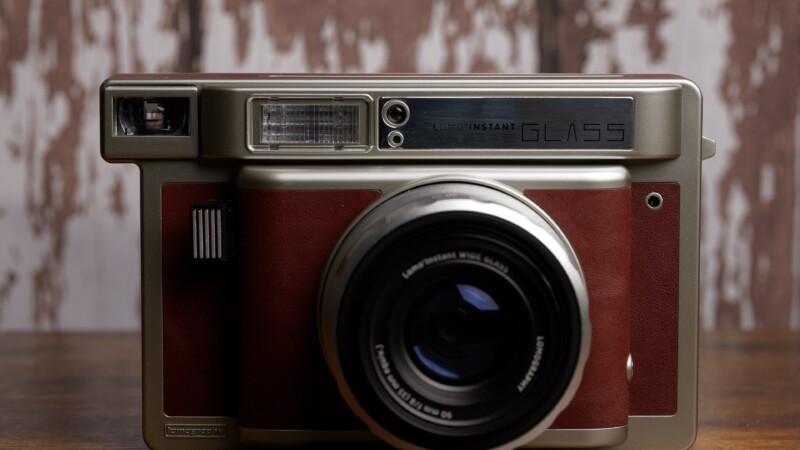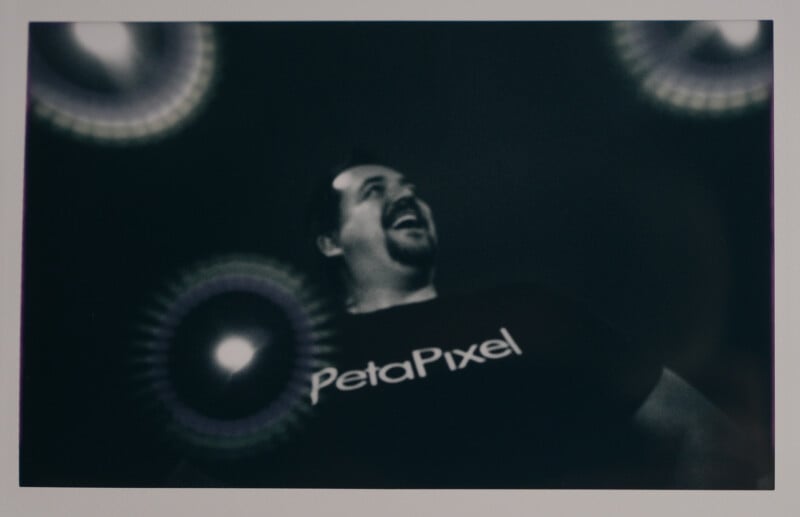The Lomography Lomo’Instant Automat Wide Glass aims to be the best instant camera on the market, and in many ways, it lives up to this ambitious goal.
When I reviewed the Fujifilm Instax Wide 400, I was enamored by the design but disappointed by the bare-bones features. It lacked any manual controls and filter effects that make instant film experimentation fun. The minuscule Instax Mini 99 was way more fun, but the smaller film format is limiting creatively. When I finally tried the Lomo’Instant Automat with its glass lens, I found that this is what an Instax camera should be. At $280, the camera is quite reasonably priced and has many accessories. Lomography, sometimes stylized “Lomo,” also makes many special editions that appeal to collectors or those who want a more personalized experience.
 The Lomo Automat Wide has to be big to accommodate the large film format.
The Lomo Automat Wide has to be big to accommodate the large film format.
Lomography is no stranger to the analog market and has made affordable and novel analog camera designs for a long time. It has a full line of film emulsions and has always strove to keep analog photography as accessible as possible to as many users as possible. The typical Lomo camera often skirts the line between functional tools and plastic toys, so the opportunity to test out a higher-end Lomography instant camera excited me.
 There are some fun accessories to try out and none of them are gimmicky.
There are some fun accessories to try out and none of them are gimmicky.
 I explored the Calgary Farmer’s Market a little bit to see how the camera handles darker conditions and artificial lighting.
I explored the Calgary Farmer’s Market a little bit to see how the camera handles darker conditions and artificial lighting.Lomo’Instant Automat Wide Glass Review: How it Feels
I’ll tell you how it feels: heavy. At 32 ounces (907 grams) the Lomo’Instant Automat Wide Glass is a bulky and weighty camera to carry around. The all-glass lens certainly adds to that weight, and the camera is awkward to carry and travel with. I like the brown leatherette on silver plastic housing, which is classy.
 The Lomo zone focuses just like the Fujifilm cameras so you need to stay vigilant.
The Lomo zone focuses just like the Fujifilm cameras so you need to stay vigilant.
 I like that the lens can accept filters and that the camera has some creative control over the exposure.
I like that the lens can accept filters and that the camera has some creative control over the exposure.
The weight comes with a feeling of quality, though. The moving parts feel solid, and I had no operation issues with the loading door, switches, or focusing mechanism. I also really like the shutter located on the front of the camera and presses inward rather than downward. The camera runs off four AA batteries and has a built-in flash and tripod socket. There is even a PC sync port to use with manual or studio flashes and Lomography includes a fun colored-gel filter kit for the flash.
 Colored filters can be mounted to the camera or placed in front of the flash.
Colored filters can be mounted to the camera or placed in front of the flash. A fun part about taking portraits with Instax film is that you can give one shot to the subjects and keep one for yourself.
A fun part about taking portraits with Instax film is that you can give one shot to the subjects and keep one for yourself.I can change my exposure one stop brighter or darker, although underexposure is almost always the way to go, given Instax film’s propensity for blown highlights. There is a multiple exposure setting that works very well. I tried it with the included Splitzer attachment, which lets me selectively expose different parts of the film before ejection. There is an auto exposure setting, which most people will find useful, and a bulb setting for long exposure work, as well as a fixed f/22 aperture setting for depth of field and a forced 1/30th of a second shutter setting for motion blur effects or dragging the flash.
 There are a few colored gels which attach right to the flash.
There are a few colored gels which attach right to the flash.
Overall, the Lomo’Instant Automat Wide Glass provided considerable control and the opportunity to experiment and play, which is essential to the instant film experience. I also found the viewfinder a little inaccurate for framing; however, it is far more useful and predictable than the debacle installed in the Fujifilm Wide 400.
 Changing exposure is a nice option to have to help control bright highlights.
Changing exposure is a nice option to have to help control bright highlights. Even the best lens will look soft if you don’t get the manual focus zone right.
Even the best lens will look soft if you don’t get the manual focus zone right.Lomo’Instant Automat Wide Glass Review: How it Shoots
Instax film quality, by its nature, can be yucky. I’ve never found the results sharp, compounded by the plastic lenses that find their way into most of these cameras. I also find that Fujifilm cameras shift the images towards a pallid, cool-tone effect, which I do not prefer. Having the larger image frame with Instax wide is worth the cost to me, but the use of a glass lens was even more critical. The results are still not razor sharp, and your focusing setting has to be appropriately set for the distance. Still, there is a noticeable improvement in detail, and I found the Lomo’Instant Automat Wide Glass to render a far more pleasing warm color palette.
Remember that digitized versions of instant film are not how the images are meant to be viewed and can’t really do them justice, but the glass lens also seems to give a pleasant tonality and overall look to the images. I’m not sure how many users would appreciate the extra detail given the additional cost of the glass lens option, but I would prefer to have one in any future instant camera regardless of manufacturer. Please take my word for it, it’s way better than the plastic versions.
 The Splitzer attachment combined with multiple exposure control was lots of fun to play with.
The Splitzer attachment combined with multiple exposure control was lots of fun to play with. The test chart shows the potential for image quality. However, detail is still limited by the nature of the medium.
The test chart shows the potential for image quality. However, detail is still limited by the nature of the medium.I had lots of fun with the multiple exposure tool on a tripod to place Jordan alongside himself, and I especially enjoyed that the lens takes 52mm filters so that I could use my old diffusion and star-effect filters. If I had more black-and-white Instax film at the time of this review, I would have also placed my old-school colored filters on the lens to change the overall contrast. Experimentation does mean lots of wasted film and, subsequently, money, too, as the biggest deterrent to any instant camera is the relatively high operational cost. At least I had fun trying all the different options, and in the end, that is what the process should be about.
 All the exposure controls make senses and are easy to implement with a little practice.
All the exposure controls make senses and are easy to implement with a little practice.
 Jordan is surrounded by either starbursts or jellyfish. I love that the lens takes 52mm filters.
Jordan is surrounded by either starbursts or jellyfish. I love that the lens takes 52mm filters.Lomo’Instant Automat Wide Glass Review: What an Instant Camera Experience Should Be
The Lomo’Instant Automat Wide Glass is what an instant camera experience should be. Easy and accessible enough for anyone to play, but with enough creative control to stimulate the more advanced photographer, too. It’s also reasonably priced at $280 and can be bought cheaper if you don’t feel the glass lens is necessary.
The main detraction will be the bulky size and weight, and some people may not love the chunky, brick-like aesthetic. Fujifilm made a very slick and sexy camera in the Mini 99 and I found the built-in LED lights to be an inspired way to add creative looks to the images. If Fujifilm could make a more capable wide format camera with the same features as the Mini 99 and an upgraded lens, people would flock to it. Until then, the Lomo’Instant Automat Wide Glass is carrying the torch for the instant film photographer who wants room to grow.
 I ended my shooting experience with some Fujifilm Instax black and white film and I like the overall tone that the Lomo lens gives.
I ended my shooting experience with some Fujifilm Instax black and white film and I like the overall tone that the Lomo lens gives.Are There Alternatives?
The Fujifilm Wide 400 is slightly less expensive and a far more simplistic experience. I like the reduced weight and curvy design, but the features are spartan. The Mint RF-70 Instantkon is a very advanced and beautifully designed camera, but the cost is high.
Should You Buy It?
Yes. The functionality is there, and the features inspire fun. The cameras look good, and the cost is reasonable too.






 English (US) ·
English (US) ·